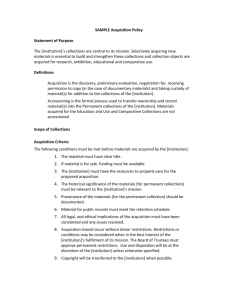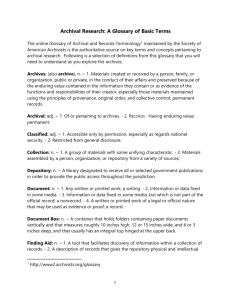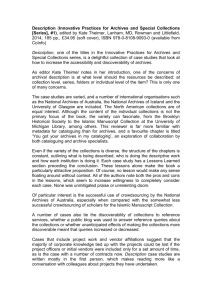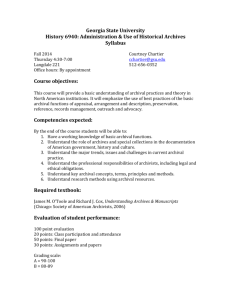Acquisition Approaches to Building Representative Collections
advertisement
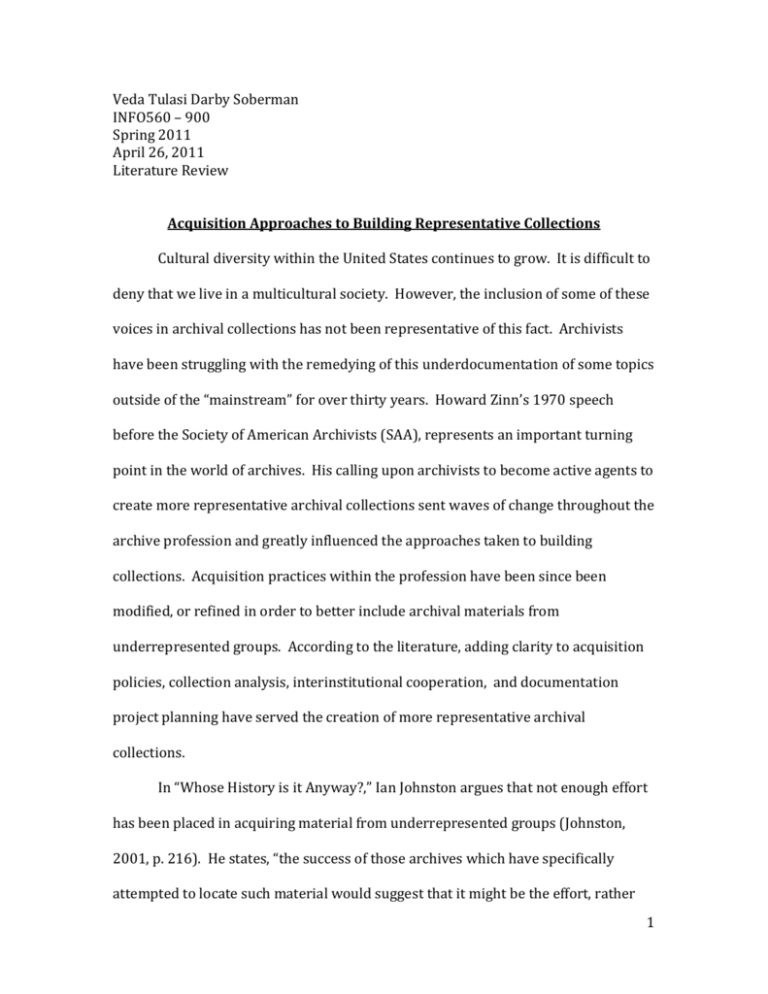
Veda Tulasi Darby Soberman INFO560 – 900 Spring 2011 April 26, 2011 Literature Review Acquisition Approaches to Building Representative Collections Cultural diversity within the United States continues to grow. It is difficult to deny that we live in a multicultural society. However, the inclusion of some of these voices in archival collections has not been representative of this fact. Archivists have been struggling with the remedying of this underdocumentation of some topics outside of the “mainstream” for over thirty years. Howard Zinn’s 1970 speech before the Society of American Archivists (SAA), represents an important turning point in the world of archives. His calling upon archivists to become active agents to create more representative archival collections sent waves of change throughout the archive profession and greatly influenced the approaches taken to building collections. Acquisition practices within the profession have been since been modified, or refined in order to better include archival materials from underrepresented groups. According to the literature, adding clarity to acquisition policies, collection analysis, interinstitutional cooperation, and documentation project planning have served the creation of more representative archival collections. In “Whose History is it Anyway?,” Ian Johnston argues that not enough effort has been placed in acquiring material from underrepresented groups (Johnston, 2001, p. 216). He states, “the success of those archives which have specifically attempted to locate such material would suggest that it might be the effort, rather 1 the material, which is in short supply” (Johnston, 2001, p. 216). Johnston’s assertion that the reason why there is relative lack of materials in collections from certain groups is not due to a lack of available materials appears to be true. Those groups which are poorly represented in archives, such as ethnic minorities, women, and those of lower socioeconomic status create a wealth of information worthy of being included in archival repositories. These groups create documents, records, and histories which hold an important part of the information necessary to understand the world in which we live. Though many archival acquisition policies were drafted since Zinn’s address in attempts to better define the collection process, Johnston notes that the creation of such policies doesn’t mean that the policies will be carried out properly, especially if they continue to be somewhat vague (Johnston, 2001, p. 217). Johnston argues that acquisition must be carried out carefully, yet aggressively, in order to develop representative collections (2001, p. 217). An example of the importance of the proper use of collection policies is given in “’Just a Bunch of Bigots’: A case study in the acquisition of controversial material” by Frank Boles. Boles describes how Clarke Historical Library’s collecting policy led to the acquisition of the records of a Michigan Ku Klux Klan chapter. The acquisition of these materials met quite a bit of opposition from some members of the community (Boles, 1994, p. 58). While the library’s collection policy allowed for the acquisition of materials which may have otherwise been lost in the ethers, Boles describes the way in which the Clarke library staff could have better communicated the fact that their actions were backed by the library’s collecting policy, and not institutional racism (Boles, 1994, p. 59). The Boles article helps us to see that a 2 well-defined acquisition policy can allow for the acquisition of items, even ones which may not be popular, but are valuable to historic research, to find the a repository in which to be housed. At the same time, the Clarke History Library’s acquisition policy could have been better utilized to support the work of the archivists had the policy been made more clear to the public (Boles, 1994, p. 59). Although this is only one case study, the controversy surrounding the situation allows us to see how collecting policies function in action. Collection analysis has also been a topic of research in regards to building archival collections. Johnston argues that collection analysis can “facilitate the establishment of collecting priorities” (2001, p. 219). Archivists evaluate their holdings in order to understand what areas may be lacking (Johnston, 2001, p. 219). These evaluations often pointed out areas of weakness centered around traditionally marginalized groups such as ethnic and racial minorities (Johnston, 2001, p. 219). With this knowledge, archivists must then actively seek these materials which are lacking (Johnston, 2001, p. 219). Collection analysis can be a tedious job for archivists to undertake, but it is an integral task (Johnston, 2001, p. 219). Johnston could provide a bit more detailed advice on how to carry out this task in the most beneficial and objective way. How can an archivist determine gaps in holdings? Understanding collections can also help to support interinstitutional cooperation, another often discussed topic of archival acquisitions. Interinstitutional cooperation is key in capturing records on diverse topics (Johnston, 2001, p. 224). Multi-institutional cooperative networks help to ensure 3 that documentation of topics is done in a comprehensive, efficient and noncompetitive manner for the sake of preserving history. Boles provides an example of successful cooperation between groups when describing how after discussions and sharing of information with many archivists throughout Michigan, the pool of institutions interested in acquiring the KKK chapter membership cards was narrowed to two interested institutions (1994, p. 58). Clarke Historical Library and Bentley Historical Library met and, after reviewing collecting policies and holdings, cordially agreed that the Clarke Historical Library would be the best institution to house the material (1994, p. 58). The Bentley Library staff even provided the contact information of the financial benefactor who had offered to help Bentley with the acquisition of the papers. Though inter-institutional cooperation seems to have worked well in this instance, Boles is quick to note that this is not always the case, as the Bentley and Clarke Library staff had an established cordial relationship (1994, p. 58). As such, the Boles example may not be the best example of the ease of attempts to work cooperatively across institutions. Brian Keough’s “Documenting diversity: developing special collections of underdocumented groups” describes the documentation strategy for building balanced archival collections originally set forth by Hans Booms (2002, p. 242). The application of a documentation plan “focuses on an analysis of the collection, setting goals and priorities for acquiring resources, planning for acquisition of new collections, and cooperating with the efforts of other institutions” (2002, p. 242). The documentation method synthesizes and clearly defines key aspects of archival acquisition of collection analysis, policy development, and cooperation in a way in 4 which archivists can follow in an ordered, disciplined manner. Keough goes on to describe the implementation of the documentation strategy in acquiring underdocumented records concerned with New York state public policy by the University at Albany, Archives of Public Affairs and Policy (APAP), which was largely funded by the New York State Archives Documentary Heritage Program (DHA) (2002, p. 244). The project resulted in a number of successful acquisitions of records from a variety of underrepresented groups including ethnic groups, women, the elderly, labor groups and environmental groups. Through the description of these successes, Keough’s article makes a good case for the use of documentation plans in the archival acquisition process, especially for the collecting of records on underdocumented topics. However, it should be noted that the successful implementation of the documentation method by APAP was supported by the New York State Archives, one of the largest and most well-funded archival repositories in the nation, and the implementation of some of the documentation practices may prove challenging for other institutions with lesser budgets. Johnston also notes that “the documentation strategy has remained a largely hypothetical model” (1994, p. 224). Creating representative collections continues to be an important task for archivists. The common methods of achieving this goal set forth in the literature are clearly defining acquisition policies, assessing collections for gaps in records, forming cooperative networks, and following the documentation strategy for specific projects. It seems that much of the research in regards to building representative archival collections has focused on these strategies. However, additional research must be done on how these methods have been employed and 5 to what effect. I would suggest more regional case studies of archival repositories of various types could aid in answering this question and supporting the acquisition of materials on underdocumented topics to reflect our growing multicultural society. Bibliography Boles, F. (1994). “Just a bunch of bigots”: A case study in the acquisition of controversial material. Archival Issues, 19(1), 53-65. Johnston, I.T. (2001). Whose history is it anyway?. Journal of the Society of Archivists, 22(2), 213-229. Keough, B. (2002). Documenting diversity: Developing special collections of underdocumented groups. Library Collections, Acquisitions, and Technical Services, 26, 241-251. I certify that: This paper/project/exam is entirely my own work. I have not quoted the words of any other person from a printed source or a website without indicating what has been quoted and providing an appropriate citation. I have not submitted this paper / project to satisfy the requirements of any other course. Signature_____Veda Tulasi Darby Soberman_____________________ Date _____April 26, 2011_______________ 6

